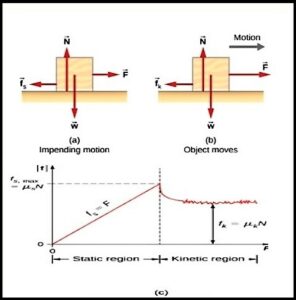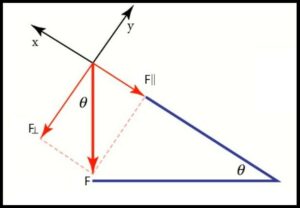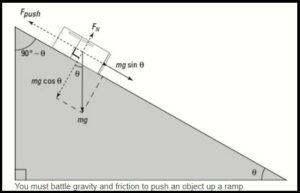The article discusses detailed facts on the work done by friction on an inclined plane and how to find it on the steeper slope.
The work by friction on an inclined plane includes the parallel components of gravitational force and friction force; since the angle of an inclined plane decreases the opposing forces such as friction and normal force, exerted by the surface of an inclined plane.
When two surfaces slip against each other, it produces friction force between them. Hence, the friction is affected initially by the nature of the surface (coefficient of friction μ) and quantity of force (normal force N) requiring them together. In the previous article, we have learned that when the body moves horizontally, its angle is zero, producing friction to resist its motion.
When the surface is inclined, the angle at which the body moves changes the friction’s strength. So friction force cannot be able to resist the motion on such a plane. Therefore, it demands to include the parallel component of gravity (msinθ) to calculate the work done by friction on an inclined plane.
Let’s discuss how friction affects the body’s motion on an inclined slope with a certain angle.

Read more about an Inclined Plane.
How does Friction work on a Slope?
When we push the body up in an inclined slope, static friction force resists the body from moving up.
On the application of force, sometimes the body remains at rest with respect to an inclined plane surface as it exerts static friction force, which resists the motion. If we increase the applied force, which is the counterpart to the static friction, the body starts to slide or roll up on an inclined plane.

on an Inclined Slope
When the body pushes down on an inclined plane, the surface exerts friction and normal force.
“The frictional force that opposes the motion is equivalent to the normal force.”
Ffric = μN ………………. (*)
μ = Ffri /N ……………… (#)
That means the coefficient of friction represents the ratio of the force required to move the surfaces and the force required to hold the surfaces together.
The angle of an inclined plane bends the direction of the normal force that pushes the surfaces of bodies together. That suggests that the normal force decreases because of the incline angle, so the friction force between surfaces. That’s why the body slides instantly down with constant motion on an inclined plane.
The rate at which the body slides down is dependent on how much the surface is inclined. i.e., angle of an inclined plane. The larger the angle, the quicker the body slides down.
But what if we want to push the body up on an inclined plane? How does friction affect its motion?
During the shopping in the supermarket, when we push the cart up on an inclined ramp, the items placed in the cart slide back. This happens because it experiences an equal and opposite force known as a static friction force that resisting the cart motion on the ramp.
Since the surfaces of the cart and ramp remain at rest relative to each other. i.e., not moving to each other, the static friction between them is less than and equal to the normal force on the cart.
Fs ≤ μsN …………………. (1)
If you apply more push to the cart, the cart slips abruptly and then start to run up on the ramp, which shows that the static friction becomes kinetic friction between surfaces of cart and ramp.
Fk = μkN …………………. (2)

(b) applied force greater than kinetic friction
(c) friction Vs applied force (credit: opentextbc)
If you place more mass items in the cart and again push the cart up on the ramp, you need to push even harder to move it.
Therefore, we studied that keeping the body in motion is more comfortable than getting started moving — that’s why the kinetic friction is less than static friction.
Read more about Frictionless Surface.
How do you Resolve a Force on a Slope?
We can resolve a gravity force by dividing it into horizontal and vertical components.
When the body is at the horizontal surface with zero angles, the gravitational force is ‘mg’. When the body is on an inclined surface with a certain angle, the gravitational force breaks into the horizontal and vertical components – to accelerate the body.
The gravitational force on the body acts perpendicular to the normal force when the body rests on the horizontal surface. In an inclined plane, the angle θ divides the gravitational forces into two components.
F||: Parallel to the plane – which accelerates the body down.
F⊥: Perpendicular to the plane – which is equal and opposite to the normal force.
Let’s draw a right angle triangle by three vectors, F, F||, and F⊥.

(credit: openstax)
We noticed that the angle of the inclined plane is the same as the angle between F and F⊥. We can use the trigonometry rule to determine the magnitude of gravitational force components.
Using a right-angle triangle,

Read more about Types of Forces.
How to find Work Done by Friction on an Incline?
The work done by friction on an inclined slope is determined by finding the net force acting and the displacement.
To calculate the work done by friction on an inclined plane, we need to determine the minimum force which causes energy conversion. The minimum force overcomes the static friction Fs and the parallel component of gravity F|| to cause the body’s displacement.

Suppose you have to push a heavy cupboard on an inclined ramp with some static and kinetic friction coefficients. Of course, you can’t do the task alone, so you need two more people to move the cupboard. So, first of all, you have to calculate the minimum force you need to apply on the cupboard to take it on the ramp.
We have already resolved the gravitational force on the cupboard into two components as per equations (3) and (4).
Suppose you know the F|| of gravitational force (mgsinθ) that accelerates the cupboard. In that case, you can easily find out the minimum force to push the cupboard by overcoming the static friction force (Fs). The minimum force is
Fpush = mgsinθ + Fs …………..(5)
There will be confusion about what friction force we should use in an inclined ramp. Note that μs > μk. That’s why static friction is the best option.
The equation (*) becomes,
Fs = μsN ………………. (6)
The normal force N acts perpendicular to the plane, opposite in the direction of F⊥ of gravitational force (-mgcosθ).
Hence, normal force N= mgcosθ …………. (7)
Therefore, the equation (6) becomes,
Fs = μsmgcosθ …………. (8)
Substituting above Fs value in equation the (5), we get the minimum force as,
Fpush = mgsinθ + μsmgcosθ ………………. (9)
When the body moves horizontally, the static friction is zero. But when the surface is tilted, the static friction force increases to counterpart the F|| of gravitational force.
If we increase an incline angle, the F|| Gravitational force exceeds the maximum value of static friction force so that the body slides on an inclined plane.
Now let’s find an inclined angle at which the cupboard slides down the ramp and give rise to total work done by friction.
Using the coordinate system, with +x down the slope and +y is up to the slope.
Using Newton’s second law,
ΣFx = max = 0
mg sinθ – Fs = 0
mg sinθ = μs N ………………(10)
Similarly,
ΣFy = m ay = 0
N – mg cosθ = 0
N = mg cosθ …………….(11)
Substituting value of N into equation (10), we get
mgsinθ = μsmgcosθ
μs =mgsinθ / mgcosθ
μs = tanθ ……………..(12)
That means the tangent angle at which the body starts to slide on an inclined slope, which has a coefficient of static friction.
Due to minimum force, the cupboard moves a certain distance (d) on the ramp. Therefore, the work done on the cupboard due to friction on the ramp is,
Wfric = Fpush. dcosθ ……………..(13)
The θ is the angle between the displacement and the friction force acting on the cupboard is 180°, which gives rise to cos180° = -1.
Hence, Wfric = – Fpush. d
Substituting equation of Fpush into above equation, we get
Wfric = – (mgsinθ + μsmgcosθ).d ……………..(14)
The above equation is the work done by friction on an inclined plane.
Read more about the Work Units.
Is there more Friction on a Steeper Slope?
The friction on a steeper slope is less due to the angle of repose.
When the surface exerts the friction force equal to the F|| of gravitational force, the body stays motionless without slipping on a steeper slope. The maximum incline angle at which the body does not slide is θ = tan−1μs. When angle θ exceeds, the maximum friction on slope decreases.

(credit: shutterstock)
On a steeper slope of the hill, the F|| gravitational force will speed the car when the car is going downward. Whereas, if the car is going upward, it will slow the car. Generally, the steep slope is rough, which still has some friction that prevents the moving car from accidents while going up and down.
Have you noticed that the car can stand still on a certain portion of the steep hill? It is because of the different angles of repose of hill slope. The car can be stationary at the slope, which has an angle less than the angle of repose. If it is equal to or exceeded, the car will slide down on the slop.
Also Read:
- Work done by friction
- How do compound microscopes work
- How does torque work
- How loudspeakers work
- How does reflection work
- How does a pulley work simple machine
- How does a fixed pulley make work easier
- How does electromagnetism work
- How does a hammer drill work
- How microphones work

Hello, I’m Manish Naik completed my MSc Physics with Solid-State Electronics as a specialization. I have three years of experience in Article Writing on Physics subject. Writing, which aimed to provide accurate information to all readers, from beginners and experts.
In my leisure time, I love to spend my time in nature or visiting historical places.
Looking forward to connecting you through LinkedIn –